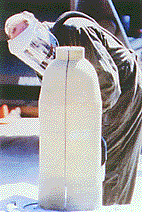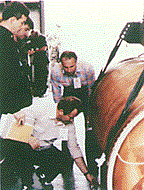 Vice President George Bush observed the first Pershing 1A elimination on September 8, 1988 at the Longhorn Army Ammunition Plant in Marshall, Texas.  Crushing of Pershing 1A rocket motor casing. |
U.S. missile eliminations began at the Longhorn Army Ammunition Plant in Marshall, Texas, on September 8, 1988.6 Both nations had agreed that the initial missile eliminations could be witnessed by senior government officials, the public, and television and print media, provided the INF on-site inspectors were not interfered with in any way. A team of Soviet inspectors, with their American escorts, went to Texas the first week in September. The first American INF missile elimination attracted an audience of several hundred. On the morning of September 8, the Vice President of the United States, the Director of OSIA, other senior officials, and almost one hundred print and television journalists watched as a 12-man Soviet inspection team arrived at the Army Ammunition Plant destruction area and conducted their preliminary inspection of two Pershing IA missile stages. As the missile stages were bolted into the static test stands, the inspection team monitored the preparations leading to the rocket motor firing. Vice President George Bush, General Roland Lajoie, Colonel Nikolai Shabalin (the senior Soviet inspector at the site), and the journalists watched as the missile rocket motors were ignited in a roar of smoke and fire. Following the missiles' destruction, Vice President Bush spoke briefly, stating that, "This is the day we began to reverse the arms race."7 In his comments, Colonel Shabalin explained the Soviet Union's motives for entering into the INF Treaty and concluded, "The world is by no means doomed to the nuclear arms race."8 |


